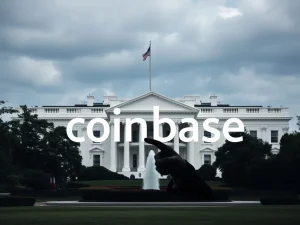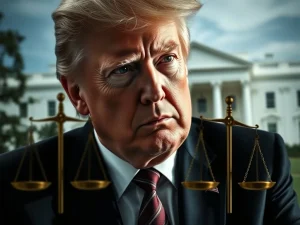Crypto Market Structure: Democrats Signal Crucial Bipartisan Breakthrough for Digital Asset Regulation

The cryptocurrency industry often faces a complex regulatory landscape. Now, however, a significant shift is emerging. Democrats are signaling crucial support for a **bipartisan crypto bill**. This development could fundamentally reshape the future of **digital asset regulation** in the United States. It offers a glimmer of hope for a clearer, more stable environment for digital assets. For stakeholders, this collaboration marks a pivotal moment, potentially moving the industry beyond fragmented enforcement actions toward a unified framework.
A Unified Vision for Crypto Market Structure
A group of Democratic senators in the US Congress recently expressed their willingness to collaborate. They intend to work with Republicans. Their goal is to advance legislation. This legislation would establish a comprehensive **crypto market structure** framework. This announcement came in a Friday statement. Twelve Democrats, including key members from both the Senate Banking Committee and the Senate Agriculture Committee, signed this statement. They released it ahead of an anticipated vote. This vote concerns a Republican-backed crypto market structure bill. Their statement emphasized a desire for collaborative legislative efforts. “We hope our Republican colleagues will agree to a bipartisan authorship process, as is the norm for legislation of this scale,” the statement clearly reads. “Given our shared interest in moving forward quickly on this issue, we hope they will agree to reasonable requests to allow for true collaboration.” This willingness to engage across party lines is a positive indicator. It suggests a growing recognition of the need for effective **digital asset regulation**.
Despite Republicans holding a majority in both chambers of Congress, bipartisan support remains vital. Legislation often requires broader consensus to pass effectively. This ensures longevity and stability. The Democrats’ push for a collaborative process highlights this necessity. Their proactive engagement aims to shape the bill. It seeks to incorporate diverse perspectives. This approach ultimately strengthens any future regulatory framework. Therefore, the outcome of these discussions holds significant weight for the entire crypto ecosystem. It impacts everything from innovation to investor protection.
Key Democratic Pillars for Robust Digital Asset Regulation
Democrats outlined their priorities for this critical legislation about two weeks ago. They proposed “seven key pillars” for a robust market structure bill. These pillars reflect their core concerns. They also aim to address current gaps in the existing regulatory environment. Among these crucial proposals are protections designed to fight illicit finance. This is a significant area of focus for many lawmakers. They also seek to “close the gap in the spot market” for digital assets. This applies to assets not currently considered securities. This specific point addresses a long-standing ambiguity. It impacts how various digital tokens are classified and regulated. Furthermore, the Democrats urged Republicans to support measures. These measures would prevent corruption and abuse within the digital asset space. They also want to combat illicit financial activities more broadly. These pillars demonstrate a comprehensive approach. They aim to create a secure and transparent environment for digital assets. Their emphasis on these areas underscores a commitment to safeguarding the financial system. It also protects consumers and investors.
This bipartisan effort aims to define clear rules. It seeks to bring much-needed clarity to the market. A well-defined **crypto market structure** could reduce regulatory uncertainty. This uncertainty has often hindered innovation. It has also deterred institutional investment. Thus, a unified framework could foster greater confidence. It could encourage responsible growth within the sector. The ongoing dialogue between parties is essential. It ensures that the final bill addresses the complexities of digital assets. It also balances innovation with necessary oversight.
Navigating US Crypto Policy: Notable Voices and Industry Engagement
The path to effective **US crypto policy** involves many voices. Not all Democratic senators signed the recent statement. Massachusetts Senator Elizabeth Warren, a top Democrat on the Senate Banking Committee, was notably absent. Warren previously shared her views during the August recess. She acknowledged the need for digital asset regulation. However, she stated she would not support legislation “written by the crypto industry.” Her stance reflects a common concern among some lawmakers. They worry about potential industry influence on legislative drafting. This perspective adds another layer of complexity to the bipartisan negotiations. It underscores the diverse viewpoints shaping future crypto legislation.
Meanwhile, Republicans are pushing forward. They aim to pass market structure legislation by 2026. This ambitious timeline highlights their commitment. Last week, several cryptocurrency industry executives engaged with Republican lawmakers. Coinbase CEO Brian Armstrong was among them. These meetings focused on discussing a path forward for crypto-related bills in Congress. Such industry engagement is crucial. It provides lawmakers with practical insights. It helps them understand the operational realities of the digital asset space. These discussions help bridge the gap. They connect legislative intent with market functionality. This collaborative approach is vital for developing effective and workable **digital asset regulation**.
The Legislative Journey: From CLARITY to Responsible Innovation
The legislative process for **digital asset regulation** is multi-faceted. The US House of Representatives passed its version of market structure legislation. This occurred in July under the CLARITY Act. However, Senate Republicans have indicated a different approach. They plan to build on this legislation. They intend to draft a distinct bill. This new bill is tentatively named the Responsible Financial Innovation Act. It is expected to proceed to a vote in the **Senate Banking Committee** by the end of September. This timeline comes from Wyoming Senator Cynthia Lummis. She is a key figure in crypto legislative efforts. Republicans anticipate the bill will be reviewed by both the banking and agriculture committees. Following these committee reviews, it would then head for a full floor vote. They aim for this by the end of the year. This structured legislative journey underscores the meticulous process involved. It ensures thorough examination and debate before a final vote.
This ongoing legislative effort is a testament to the growing importance of digital assets. Lawmakers are increasingly recognizing the need for a clear and comprehensive framework. Such a framework would govern the burgeoning crypto industry. A well-defined **crypto market structure** can foster innovation. It can also protect investors. Moreover, it can ensure market integrity. The bipartisan engagement signals a mature approach. It moves beyond initial skepticism. It focuses on practical solutions. The outcome will undoubtedly shape the future of **US crypto policy**. It will have lasting implications for both domestic and global digital asset markets.
The Promise of a Bipartisan Crypto Bill
The potential for a **bipartisan crypto bill** offers significant advantages. It signals stability. It suggests that future regulations might withstand political shifts. This long-term view is vital for an industry. The crypto industry thrives on certainty. A unified approach also lends greater legitimacy to the regulatory framework. It helps prevent piecemeal or contradictory rules. Such consistency benefits all participants. It empowers businesses to plan. It enables innovators to build. And it provides investors with confidence. The discussions in the **Senate Banking Committee** are therefore critical. They represent a key hurdle in this legislative race. Successfully navigating these committee votes will pave the way for broader consideration. It will bring the industry closer to a clear regulatory future. This collaboration could set a precedent. It could show how complex emerging technologies can be effectively integrated into existing financial systems. This truly marks a transformative period for digital assets.








